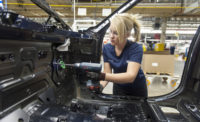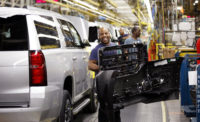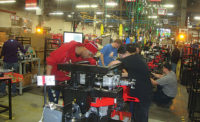Fiat invested $700 million in a state-of-the-art body shop that features new machinery, tooling and material handling equipment exclusively for production of the Dart. “This new facility sets the benchmark for future Chrysler Group body shops in terms of design, efficiency and flexibility,” says Scott Garberding, senior vice president of manufacturing at Chrysler Group LLC.
“Standardizing body shop design across the company allows for greater flexibility to build several platforms based off the same architecture at more than one plant,” adds Garberding. The new 702,000-square-foot Belvidere North body shop has the ability to build up to four unique body styles.
Several innovations were adapted from Fiat plants in Europe, such as the Tychy, Poland, facility that assembles small cars like the popular Fiat Panda. For instance, the basic robotic integrated configuration (BRIC) is a new standard equipment design that’s used on many of the welding and sealing applications in the plant.
“BRIC reduces installation time, because robots, equipment and associated electrical control panels are shipped as a complete unit,” says Steve Hughes, senior body shop manager. “It eliminates the need to disassemble equipment at the [robot supplier] and reassemble it at the plant. A welding and sealing station can be installed at the plant in approximately one hour, compared to several days in the past.”
The BRIC design also allows manufacturing engineers to mount robots overhead, which saves valuable space on the plant floor. The new body shop features 967 robots. More than 63 percent of the machines were redeployed from Chrysler’s recently closed St. Louis plant, resulting in a total savings of about $29 million.
Another unique feature of the body shop is an open gate framer, which was developed by engineers at Comau, a Fiat subsidiary. It consists of 18 robots (eight mounted on the floor and 10 hung from above) that weld panels to the body, ensuring “a consistent and dimensionally repeatable build of each vehicle.”
Extensive use of lasers for various measurement and welding applications also ensure consistency and quality. “The roof laser braze welding process allows for a seamless transition between body side aperture and roof panel mating surfaces,” says Hughes. “An automated closure panel installation line utilizes measurement lasers to tell the panel installation robot exactly how the decklid, doors, fenders and hood panels should be installed to meet exacting fit and finish specifications.”
Material handling is done differently in the new facility vs. the older, 965,000-square-foot Belvidere South body shop, which boasts 856 robots. For instance, it uses a marketplace concept that feeds appropriate parts to specific areas of the assembly line, reducing fork lift traffic on the plant floor. Instead of delivering parts to 285 locations, there are now only 30 delivery points.
“The layout of the new body shop is much more efficient than traditional body shops, because all material and processes are manned from the same side of the line,” says Hughes. “That condenses line-side inventory and the number of operators required to load the equipment.”




